
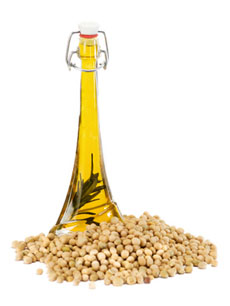
Soybean oil is a fairly healthy oil: high in Omega-3 fatty acids and vitamin E, rich in polyunsaturated fatty acids and monounsaturated fats and fairly low in saturated fat. Photo by Jovan Nikolic | Fotolia.
November 2006
Last Updated October 2012
|
 |
Types Of Cooking Oil
Page 6: Types Of Cooking Oil ~ S To Z
This is Page 6 of a six-page glossary of the types of cooking oil. Click on the black links below to visit other pages. Also see our many other delicious food glossaries.
SAFFLOWER OIL
The safflower is a member of the thistle family. Its seeds are pressed for safflower oil, a light, neutral-flavored oil which has the highest level of polyunsaturated fat of any edible oil. While it is low in saturated fat (second only to canola oil), it has a low level of monounsaturated fat and contains no vitamin E, so it is not as nutritious as other oils. However, it has a very high smoke point so it is an excellent oil for deep-frying, pan-frying and sautéing. It also can be refrigerated without solidifying. Safflower oil is also used to make margarine.
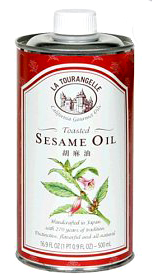 SESAME OIL SESAME OIL
Unrefined sesame oil is made by crushing sesame seeds and filtering the resulting oil, which is light and has a mild flavor. It is very popular in Middle-Eastern and Indian cooking, and gives good flavor to stir-frys and salad dressings. Dark sesame oil is where the excitement lies: the seeds are toasted before crushing to produce a darker oil with an intense fragrance and robust flavor (it is very strong—we often mix 1 tablespoon of it along with 2 tablespoons of olive oil in a classic vinaigrette). in stir-frys and marinades for meat or fish, blending dark sesame oil with milder oils will tone down the pungent flavor.
SMOKE POINT
The smoke point is the temperature at which an oil begins to decompose from the heat. It gives off visible fumes (smoke) and an unpleasant odor as it breaks down. While most oils can be used to quickly sauté, for high-heat cooking it is important to choose an oil with a high smoke point. View a complete list of smoke points by type of nut.
SOYBEAN OIL or SOY OIL
Soybean oil boasts many of the same health claims as soybeans: high in Omega-3 fatty acids and vitamin E, rich in polyunsaturated fatty acids and monounsaturated fats and fairly low in saturated fat. It is highly refined and has a high smoke point, making it a good all-purpose cooking oil. It is commonly used in the manufacture of margarine, vegetable oil and shortening, in commercial food production, and in Chinese cooking. Generic brands of vegetable oil are often 100% soybean oil. It is one of the more inexpensive oils, and often used to make commercial mayonnaise.
SUNFLOWER OIL
Sunflower oil is an all-purpose high-heat cooking oil with the added benefit of a high 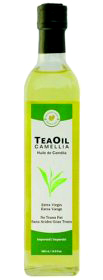 monounsaturated fatty acid content and a high level of vitamin E. It is a light yellow color and has a mild flavor that is suitable for salad dressings. Like most other refined oils, it has a fairly high smoke point (see above). monounsaturated fatty acid content and a high level of vitamin E. It is a light yellow color and has a mild flavor that is suitable for salad dressings. Like most other refined oils, it has a fairly high smoke point (see above).
TEA OIL
Tea oil is cold-pressed from the seeds of the tea plant, Camellia sinensis. A pale amber-green in color, the oil has an herbal aroma with a somewhat sweet flavor. It is high in vitamin E and other antioxidants, contains no trans-fatty acids, is lower in saturated fat than olive oil and is non-hydrogenated. It is often used in Asian foods and it can be served as a salad dressing when it is combined with other flavors, such as lemon or lime. Tea oil has a high smoke point so it can withstand high-heat cooking without burning. While it is relatively new in the U.S., it can be added to cooked vegetables, pasta, dips, dressings, marinades and sauces.
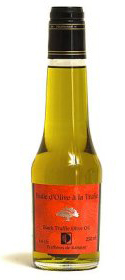 TRUFFLE OIL TRUFFLE OIL
Most truffle oil contains little actual truffle, but is produced by infusing olive or other oil with the flavor of truffles—generally a chemical essence that smells and tastes like truffle. In a very few instances, truffle pieces are soaked in a high-quality, extra virgin olive oil until the absorbs flavor and aroma. That’s why the black truffle oil of Eugenio Brezzi, a noted truffle purveyor, costs $132 an ounce, while 4 ounces of “chemical” truffle oil can cost $10. But both, at their own levels, can be used to add the truffle flavor to a variety of foods ($132 an ounce is close to the price of actual truffles, so one might simply go for the real thing). Truffle oil must be tossed on or dribbled onto food, since heating the oil will cause the flavor and aroma to dissipate. Similarly, an open bottle of truffle oil will lose its flavor quickly and should be used up in a short period of time. The oil, which is available in both black and white truffle varieties, is used in small amounts in pasta sauces, risottos and, meat and poultry dishes. Learn more about truffles.
UNFILTERED OIL
Unfiltered oil contains natural particles that have not been removed, which leaves oil cloudy. This can include pieces of the fruit or nut. Unfiltered oil aficionados claim this adds additional flavor. Unfortunately it causes a sediment to form at the bottom of the bottle over time which can become rancid, negatively impacting flavor and shelf life. Unfiltered oil should be carefully stored and used within three to six months of bottling.
VEGETABLE OIL
Vegetable oil can be a blend of oils , e.g. corn, soybean and sunflower, or it may be only one type of oil. There is no requirement for the label to list the type(s) of oil in the bottle. Generally, “vegetable oil” is refined to have a high smoke point but very little taste or aroma. This makes it a good all-purpose oil for baking, frying and sautéing. However, it is not of sufficient quality to be used as a condiment oil or for salad dressings.
VEGETABLE OIL COOKING SPRAYS
Aerosol cooking sprays propel a very small amount of oil from the can, so it adds negligible calories. The flavored sprays are more interesting, even when just “greasing the pan.”
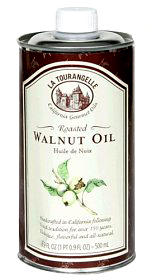 WALNUT OIL or HUILE DE NOIX WALNUT OIL or HUILE DE NOIX
Walnut oil is a rich oil redolent of walnut flavor, extracted from the meat of walnuts by pressing. As with other nut oils, it is used in baking, salad dressings and sauces, and it is more expensive than vegetable oils. High in polyunsaturated oils, including Omega-3s, it is delicious drizzled over endive scattered with blue cheese and toasted walnuts, or drizzled over fresh goat cheese, sprinkled with chopped toasted walnuts. Other favorite uses include with slices of pear, apple or Asian pear for a fruit and cheese course, brushed on grilled poultry and fish, or as a garnish for root vegetable soup, corn chowder or puréed squash. See Nut Oil, and read our review of La Tourangelle nut oils, a NIBBLE Top Pick Of The Week.
WHEAT GERM OIL
Wheat germ oil is obtained from the embryo of the wheat kernel. It is delicious in salad dressings; health food aficionados discovered it was equally delicious when tossed with pasta. As with flaxseed oil, it is a rich source of vitamin E and is most often used as a dietary supplement.
Go To Page 1: Terms A & B
Go To The Article Index Above

|








